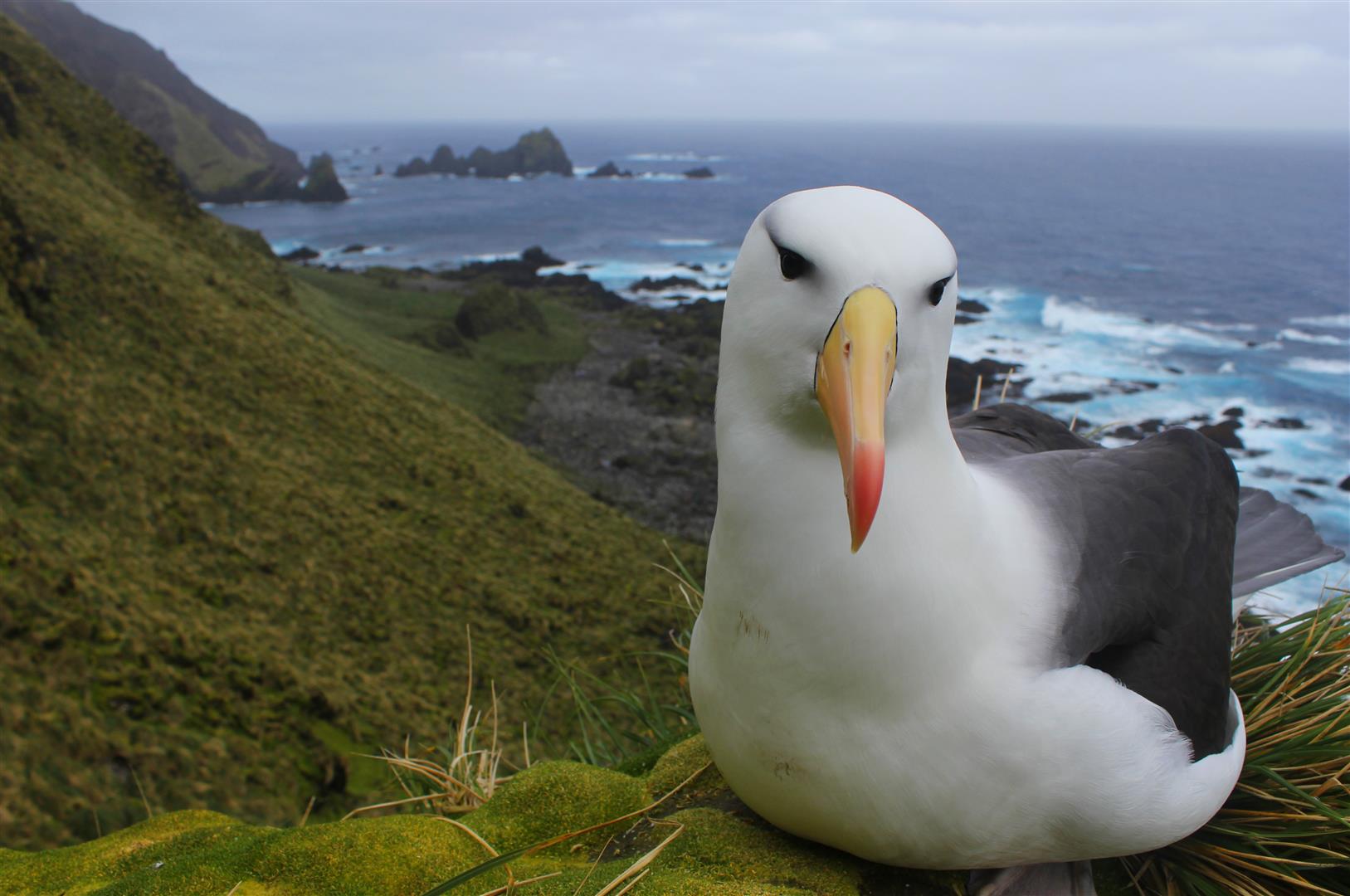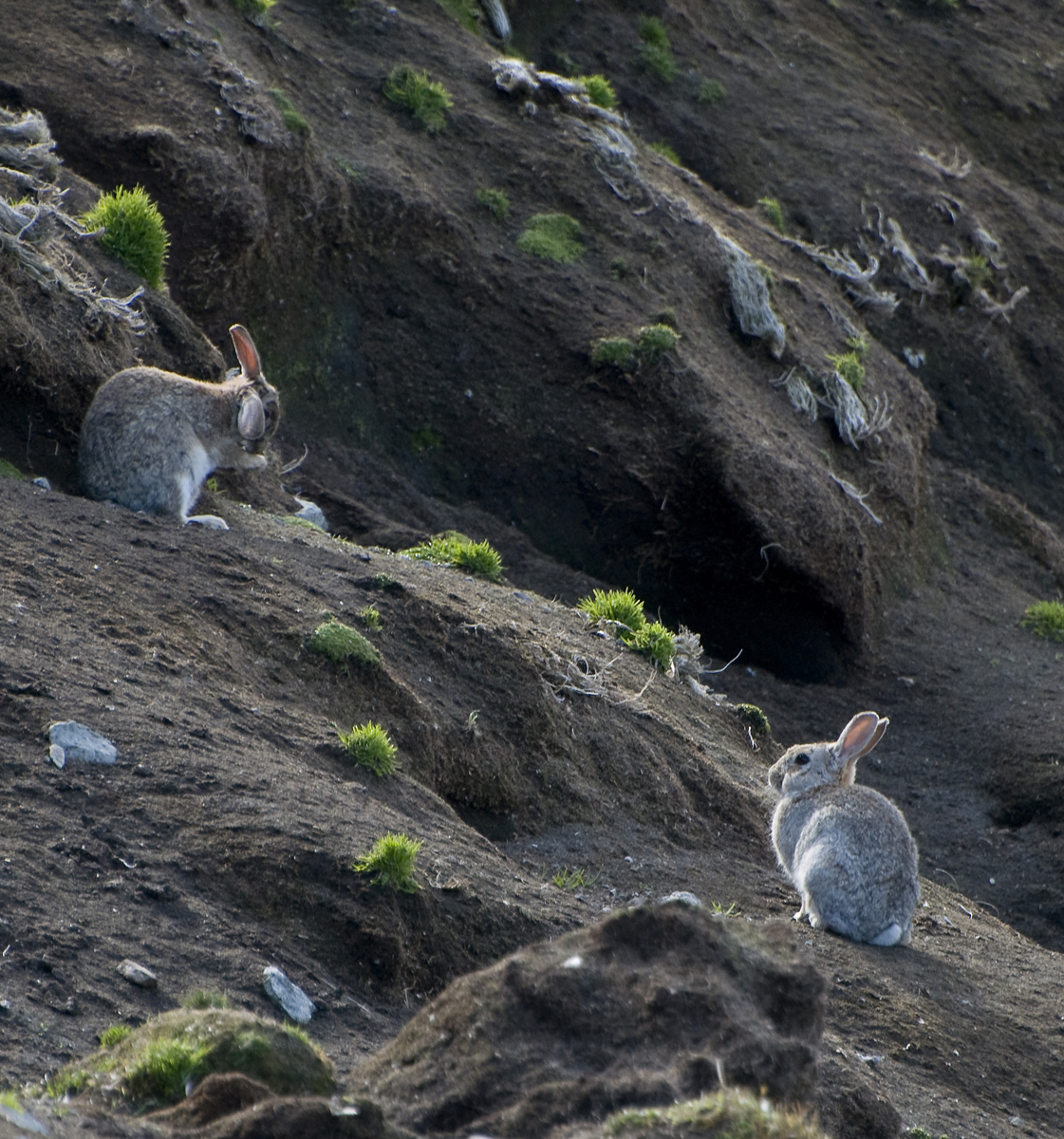
A Black-browed Albatross on Macquarie Island, photograph by Melanie Wells
Nick Duigan, Tasmanian Minister for Parks and Environment and Tanya Plibersek, Federal Minister for the Environment and Water have issued a joint communique to mark a decade of Autralia’s sub-Antarctic Macquarie Island being free of introduced vertebrates. The media release text follows:
“In April 2014, a major project to eradicate all rabbits and rodents from Macquarie Island was officially declared a success. Ten years on, the island is showing remarkable signs of recovery, with lush vegetation lining its once barren slopes and the return of breeding seabirds such as burrowing petrels. Macquarie Island is located halfway between Tasmania and Antarctica. It is one of Australia’s most significant conservation reserves and listed as a UNESCO World Heritage Area.

A view of Macquarie Island, photograph by Aleks Terauds
Planning for the Macquarie Island Pest Eradication Project began in 2007 with the aim of removing three introduced pest species – rabbits, rats and mice – and restoring the island’s outstanding natural values. The [AU]$24 million project was co-funded by the Tasmanian and Australian Governments and managed by Tasmania Parks and Wildlife Service with the assistance of the Australian Antarctic Division. Tasmanian Government Minister for Parks and Environment, Nick Duigan, said it was the most ambitious pest eradication program conducted in the state’s history.
“The introduction of rabbits, rats and mice to Macquarie Island had devastating impacts on the island’s natural wildlife and ecology,” Minister Duigan said “Overgrazing by rabbits caused extensive loss of vegetation cover, destroying the breeding grounds of nesting seabirds and triggering widespread erosion. Rats preyed on seabird eggs and chicks, while mice ate insects, worms and other invertebrates, disturbing the ecological balance of the island.
“Following years of meticulous planning, the Macquarie Island Pest Eradication teams of 2011 and 2012 successfully rid the island of all three targeted species. This remarkable outcome is testament to the tireless efforts of the rangers, baiters, hunters and their support crews who delivered the program in remote and challenging conditions. We thank them for their contributions. We also acknowledge Tasmania Parks and Wildlife Service for its ongoing management and preservation of the outstanding universal values of Macquarie Island.”

No longer a problem. Denudation and erosion caused by European Rabbits on Macquarie Island, photograph by Aleks Terauds
Federal Minister for the Environment and Water Tanya Plibersek said the eradication of rabbits and rodents had huge benefits for threatened species on the island.
“Macquarie Island is a wildlife wonderland – home to millions of penguins, seals and seabirds. It is fantastic to see the island’s plants and animals thrive 10 years after the eradication of rabbits and rodents. “The increase in vegetation cover has improved breeding habitat for albatross and the eradication of rodent predators has seen burrowing petrels flourish. The long-term benefits and impacts of the pest eradication program will continue to be monitored through the 10-year Macquarie Island Wildlife Monitoring Program.”
“This project will assess wildlife populations on Macquarie Island so we get an accurate snapshot and monitor trends over time. The data will allow us to better protect this exceptional place for our kids and grandkids.
“This is a great example of our government’s commitment to restore damaged landscapes and shows what marvellous results can be achieved. The Australian Government also announced in this month’s budget we will rebuild the station on Macquarie Island to continue world-leading science like this.”

Trained dogs were used to help eradicate European Rabbits, Black Rats and House Mice on Macquarie Island, photograph by Tasmania Parks and Wildlife Service
Macquarie Island has a long history of battling the impacts of introduced pests. The island was discovered by sealers in 1810, and they brought with them cats, dogs and rodents. From the 1860s they introduced rabbits and Weka as a food source. Weka were eradicated in 1989 and feral cats were eradicated by 2000, but rabbits, mice and rats continued to thrive.
By the mid-2000s, the rabbit population was estimated to exceed 125,000. After extensive planning and research, calicivirus was introduced to Macquarie Island in February 2011 and proved very effective, killing an estimated 80-90 per cent of the rabbit population in a few weeks. This was followed by an aerial baiting programme in the winter 2011. The last rabbit was recorded on the island in November 2011, and after three years of intensive patrolling by conservation dogs and their handlers, the project was declared a success in 2014.
Read video interviews here and here on the island's recovery.
John Cooper, Emeritus Information Officer, Agreement on the Conservation of Albatrosses and Petrels, 30 May 2024

 Español
Español  English
English  Français
Français